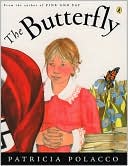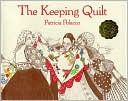 Polacco, Patricia.
Polacco, Patricia.Tikvah Means Hope.
1994.
Delacorte Press.
Guided Reading Level: P
If nothing else, this story will allow children to feel hope when times are trying! It is definitely an inspiration, but I feel that if children/students are truly going to understand the story, the author's note (from the last page) must be shared in some form (not necessarily just reading it to the kids, either, but really talking about it) so the message is clearly relayed.
Justine and Duane, two friends, spend much time with their Jewish neighbor Mr. Ruth, as he prepares for Sukkot, the Jewish Thanksgiving holiday by building the Sukkah (the place where the feast will be held). As the preparations begin, Mr. Ruth shares with the youngsters the reasons for having the celebration in a Sukkah, rather than around a table inside the house. As the day of Sukkot approaches though, gales of wind also approach in Oakland, causing fires that literally destroy the town. As the townspeople are driven out as part of an evacuation plan, Justine's kitty, Tikvah (which means hope in Hebrew) is left behind. The fire burns for days, destroying nearly everything in its path. When Justine, Duane (and their families) and Mr. Ruth return to Oakland they find their homes in ruins, however, hope is left behind as the Sukkah remains standing, unburned, and as the neighbors all gather for a barbecue, the small purring sounds of Tikvah also surface. These two small signs provide neighbors with exactly what they need to survive this tragedy - hope.
Lesson Plans/Reading Activities:
 Polacco, Patricia.
Polacco, Patricia.Mrs. Katz and Tush.
1992.
Bantam Doubleday Dell Publishing Group, Inc.
Guided Reading Level: P
This story introduces young readers to the Jewish celebrations of Hannukah and Passover. The celebrations are only briefly touched upon, but are definitely enough to allow children the chance to appreciate and respect Jewish heritage.
Larnel and his mother pay a visit to a grieving Jewish neighbor, Mrs. Katz, who's husband recently passed away and who is facing her first Hannukah and Passover without any family. Larnel quickly befriends Mrs. Katz and presents her with a kitten, hoping to brighten her spirits . Mrs. Katz agrees to care for the kitten, who becomes known as "Tush" (because of its lacking tail), but only if Larnel agrees to help her out (I think her real motive is in needing a friend)! As the two spend more and more time together, she shares with Larnel bits and pieces of her Jewish culture, allowing for him to experience them alongside his own, and to see the similarities between Jewish and African Americans. The story has a bittersweet ending, as Larnel continues sharing what he's learned of the Jewish culture with his own young family (his wife and children) by visiting Mrs. Katz at her burial site.
This book, like most of Polacco's has a deep story waiting to be told! It's going to take someone with the right amount of knowledge and ability to share this story in a way that children can relate to but it's definitely worth a read and would make for a great story as part of character education on diversity!
Lesson Plans/Reading Activities:
- Mrs. Katz and Tush Lap Book
- I Am Special - Kindergarten
- Understanding Judaism and the Jewish Community
 Polacco, Patricia.
Polacco, Patricia.The Butterfly.
2000.
Philomel Books.
Guided Reading Level: NR
This is perhaps the deepest of all of Patricia Polacco's stories that I have read. Perhaps it is because of the content and information being shared... the Holocaust. I think this is a very difficult time period to teach to children, as it was one of the darkest times in our history. However, that being said, I think Polacco has handled the subject in a very appropriate and delicate manner that will give children a basic understanding of the Holocaust without making it a traumatic learning experience at a somewhat young age.
Despite the recent activity in her French village (Nazi troops terrorizing the area), Monique, a young girl, is quite shocked when "a ghost" visits her during the night. As time passes and Monique discovers that the ghost is not really "a ghost" but rather another little girl her same age, Sevrine, a Jewish child whose family has taken up residence in Monique's basement, seeking safety from the Nazi troops. The two become quick friends and appear to be like all little girls, playing - enjoying their life, even though Sevrine is sharing with Monique all of the trying times that her family has been through.
One day, as the girls are enjoying a butterfly at a window from the house, Sevrine is spotted and the family must once again set forth to a new destination to try and escape the Nazi forces. Monique, sad to lose her new friend and afraid of what Sevrine's future holds, gives Sevrine her precious cat, Pinouff as a parting gift - a way for Sevrine to remember Monique. Upon Monique returning to her home after seeing Sevrine off, Monique is giving a sign of hope - that leaves Monique feeling content and knowing that Sevrine and her parents are safe in their new hiding place.
This book definitely shares with children the aspects of the Jewish heritage that is most known to us. It does a good job of providing children with a child's view of the Holocaust and the impact that the Holocaust had on children... definitely worth a read, but I'd say that the Holocaust and World War II must be shared with students to some extent if they are going to take the most from this book!
Lesson Plans/Reading Activities
 Polacco, Patricia.
Polacco, Patricia.The Keeping Quilt.
1988.
Simon & Schuster, Inc.
Guided Reading Level: M
Love, love, love The Keeping Quilt. Love it even more since I've had the opportunity to experience one aspect of Jewish Heritage that focuses around a "keeping quilt" - a half Jewish wedding (my cousin, who's not Jewish, married a Jewish man and their wedding ceremony incorporated many important Jewish traditions)! It was an experience I'll never forget!
Polacco tells the story of when her great-grandmother came to America in The Keeping Quilt. Anna, a young girl, moves to America with her family. Like many immigrants there was little room to bring worldly possessions, and therefore, the only physical reminder Anna has of her life in Russia is her dress and babushka. However, she quickly outgrows them. Her mother, being quite handy, takes the dress and babushka, along with Uncle Vladimar's shirt, Aunt Havalah's nightdress and Aunt Natasha's apron and uses the material to make a quilt that will help Anna and her family to remember home for generations to come. As time passes, the quilt serves many purposes... a tablecloth, a picnic blanket, a wedding huppa, and a receiving blanket put to good use by many generations. The story ends as Polacco shares with readers that someday, her own daughter Traci Denise will have possession of the blanket so that she can pass it on to her own children and be able to share this part of Jewish heritage with her own family.
I think this is a really cool idea... definitely allows for the sharing of stories from generation to generation. Why not start a keeping quilt of your own with your family that will be a prized family possession for years to come?
Lesson Plans/Reading Activities
- The Keeping Quilt - Web Activities
- A Patchwork of Cultures - Who Am I?
- Quilts of Many Colors
- The Keeping Quilt - 6 Lessons
If you're interested in finding out more information about any of the books reviewed or if you'd like to purchase the books, click the cover image for a link to Amazon.com.








0 comments:
Post a Comment